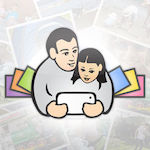Using Our Story to engage with language and literacy
Ideas for Using Our Story to help Very Young Children with Word Learning
One activity you could try with the Our Story is similar to what has been called the 'original word game'. This simply involves asking children 'what is that?' and if they don't know supplying the answer. This is a very effective way to help young children learn new words. So, for example, you could take a picture of your dog and ask your child 'What is this?' and ask him or her to point to the picture. You can make this game different by adding noises to the picture such as a cow going 'moo' or adding some speech to the picture such as 'what's this?'
Children usually enjoy learning new words and with our app, you can make this great fun for them. Remember, your tone of voice, excitement, and smiling face are all part of the vital ingredient which makes learning fun. If you don't enjoy the game, then your child will probably pick this up and feel the same!
Research shows that children are 'word learning machines', they learn new words at an amazing rate; it is estimated they add 8 words to their vocabulary every day and so by 6 years know up to 6000 words. It also is worth emphasising that the more words a child knows, the better they are likely to be at reading, and making the most of their school education.
Some quick tips about children who are starting to read
Helping your child to identify the separate sounds in words
This game with letters can help with another pre-reading skill that involves understanding that words can be broken down into separate sounds. Showing pictures with the same beginning sounds can help children to pick out particular sounds in a group of words (e.g. bat, ball, bottle, etc.), and you can also ask your child to make the beginning sound of the pictures they see, but they are likely to find this very difficult. You can do the same thing with pictures of objects that rhyme. Research has shown that the ability to break words down into their separate sounds is important when learning to read.
Often for adults this seems so obvious that it is easy to forget that young children usually treat words as a whole sound and it is difficult for them to identify the separate sounds within a word. There is a lot of research that suggests this skill is very important for reading because one of the major tasks that children face is to learn the links between letters and sounds. And the reason we as adults often think this is easy is partly because we have learned to read!
Helping your child with letters
Another important pre-reading skill is being able to recognise the letters of the alphabet. On our app you can show a letter of the alphabet with a relevant photo. So you show your child sets of pictures which begin with the same letter – for example, ball, bat, bun, etc. In this way, your child can both start to recognise the letters of the alphabet and also associated each letter with a relevant sound. If your child does not seem to understand or is unhappy with the 'game', try to include words your child is already familiar with - remember to not push things too far, come back in a few months and see if they are happier with the game.
Helping your child read words
For older children, you can add the written name to the picture. This means your child will start to see the whole word with a picture and later on, you can ask your child to read the name and later still, read whole sentences. Be patient, remember having fun is more important than making fast progress.
Further information about these ideas is available at OpenLearn.
Are you already an OU student?
Request your prospectus
Explore our qualifications and courses by requesting one of our prospectuses today.
Request prospectus
